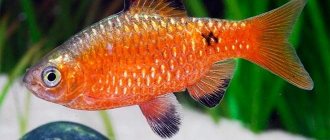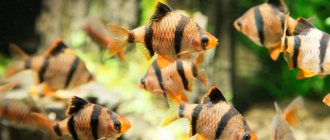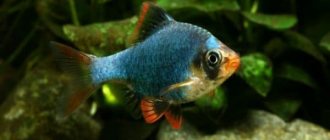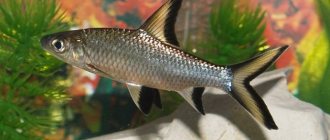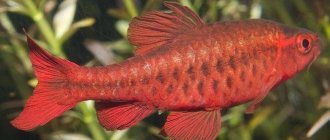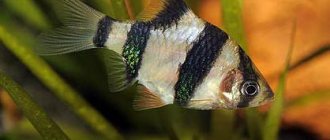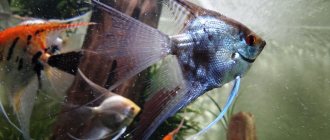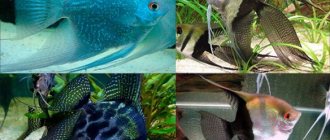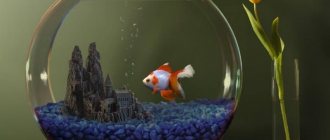Scarlet barb (Pethia padamya) is an active schooling fish from the carp family. This species received its name for its bright original colors. For a long time it was considered a variant of the ticto barb (Puntius ticto), the natural color of which does not include a wide scarlet stripe. Only in 2008, ichthyologists gave a scientific description of the scarlet barb and assigned it the status of a separate species.
In Russia, this aquarium fish is often called the Odessa barb, since it was first brought to our region through this city. The novelty won the hearts of many aquarists in a matter of years. Unpretentiousness, modest size and spectacular coloring have ensured the scarlet barb's continued popularity.
Natural habitat
In nature, the barb Pethia padamya can be found in Southeast Asia, in countries such as India, China, Burma, Laos, Pakistan, Nepal, Bangladesh. It is widespread in large waterways of the region: the Mekong, Meklong, Irrawaddy, etc. The scarlet barb prefers quiet backwaters with a muddy or pebble bottom, places shaded by vegetation.
The species owes its scientific name to the area in the Irrawari River basin, where the fish was called Pethia padamya, which translates from Burmese as “small ruby-colored fish.” To this day, in some catalogs it is listed as a ruby or red barb.
In the natural environment, scarlet barbs grow up to 7 cm, in captivity - a little smaller. It is rare to find an aquarium specimen more than 5 cm in length.
Where does the barb live?
Photo: Barbus fish
Regarding the Sumatran barb, this question is not relevant - from the name it is easy to guess that the main “registration” of this fish is the island of Sumatra and the regions of Southeast Asia nearby. The natural habitats of the fire barb are the water basins of northeastern India.
The main requirement that these bright and cheerful fish place on a pond is the absence of intense current - unpretentious barbs will populate a lake or pond with stagnant water. Rivers with weak currents are also suitable.
The homeland of the cherry barb is considered to be Southeast Asia (more specifically, the island of Sri Lanka). The fish lives (in fact, almost like all its relatives) in stagnant and sluggishly flowing reservoirs. Another criterion for the suitability of a reservoir is a dark, silty bottom.
The cherry barb first arrived in Europe in 1936, and in the USSR in 1959. Like the Sumatran, the red barius is a common resident in hobby aquariums. There is also an albino form of the cherry barb, but these individuals are considered mutants and are not in demand among aquarists. Some breeders sell them to beginners at exorbitant prices - under the guise of “rare tropical fish.” And this is where marketing comes in!
The above-mentioned Denisoni barb was originally discovered by the explorer whose name it immortalized in the waters of the Manimala River (near the city of Mundakayam, Kerala, southern India). The species is notable for being endemic to the Indian states of Kerala and Karnataka. Small populations can be found in the Valapatanam, Chalia and Kupam river basins.
But still, the main habitat of almost all representatives of the Barbus genus is the aquarium! An ideal aquarium for any barb should have an elongated, somewhat elongated shape (and in no case round) - this is necessary so that the frisky fish have the opportunity to “get up to speed.” The presence of floating plants, bright lighting, powerful filtration and aeration are necessary conditions for the successful breeding and maintenance of barbs.
Editorial: Queen aulonokara nyasa
Appearance
The Odessa (scarlet) barb has an oval body, flattened on the sides and covered with large dense scales with a well-defined mesh pattern. The back is painted in greenish-gray tones, the belly is light, the sides are silver with a metallic tint. There are dark round spots just behind the gills and at the base of the tail. The fins are gray, translucent, decorated with clear black strokes.
Differences between males and females of the scarlet barb.
A distinctive feature of males is a wide red stripe running along the body . Sexual demorphism in this species is also expressed in the size of individuals and body structure: females are larger and rounder.
What does a scarlet barb look like?
These are small fish, about 5-6 cm long, very rarely growing up to 10 cm. Their body shape is oval. It is elongated in length and laterally flattened.
The back is painted grayish-green, which gives way to silver on the sides, and the belly is completely light. The fins on the back are covered with dark specks, and on the belly they are red.
Dark spots with a golden border are clearly visible near the tail and above the pectoral fins. The scale pattern is also quite distinct, in the form of a grid. A bright red stripe stretches along the entire body, for which these barbs were called scarlet.
Males are smaller and brighter than females. Their body is often colored pink. And the red stripe on the side is especially pronounced during the spawning period.
If cared for well, they can live 3 years or more.
Compatibility with other types
The Odessa barb is a completely peaceful fish, which is most interesting to watch in a school of its own kind. In a community aquarium, he will get along well with equally active fish that are similar in size to him. Good neighbors for a flock of ruby barbs will be:
- Sumatran barb;
- Barbus mutant;
- denison;
- zebrafish;
- Malabar zebrafish;
- Congo;
- neons;
- tetras.
Although the scarlet barb behaves quite peacefully in a community aquarium and is focused mainly on relationships within the flock, it is not recommended to keep it with slow-moving species. Often such cohabitation ends with the stripped fins and tail of a more phlegmatic fish.
Red – poor compatibility; yellow – limited; green – good compatibility.
Barbs do not show interest in bottom fish, such as loaches and catfish, nor do they show interest in aquarium shrimp.
Conditions of detention
Scarlet barbs must be kept in schools (from 6 individuals), otherwise the fish become aggressive, often get sick and often die . For a small flock, a tank with a volume of 80 liters or more is suitable, spacious enough for endless games of this fun campaign.
The beauty of these fish is most clearly manifested in an aquarium with dark soil and a background, where the light from the lamp is muffled by floating aquatic plants (Riccia, Pistia, Azolla).
These fish feel best in schools.
You shouldn’t overload it with decorations; you need to leave enough free space for swimming. It is advisable to plant long-stemmed and small-leaved plants along the perimeter, for example, vallisneria, elodea, cryptocarina, hornwort, ambulia, hygrophila, lemongrass.
The scarlet barb is considered by aquarists to be an unpretentious and even hardy fish, but still, it is better to keep it in water with parameters favorable to it:
- acidity – 6.5-7.0 pH;
- hardness – 5-15 dGH;
- temperature – 20-25°C (slightly lower than that of the closest species).
Pethia padamya prefer clean, oxygenated water. The aquarium where they are kept should have a good filter, which, in addition to cleaning, provides a weak current, similar to their natural habitat. Partial water changes (about 30%) should be done weekly.
Like most aquarium fish, the Odessa barb reacts negatively to sudden changes in water parameters.
BARBUS ODESSA (Barbus „odessa”)
FSB
0
23 435
Share
The history of the origin of the Odessa Barbus is very interesting, it is not fully known for certain. Some argue that this type of fish does not occur in nature. In 1971, information about the discovery of new species of barbs spread on the market in Odessa. This species began to be grown on a large scale due to its relative ease of reproduction. But the true roots of the origin of these fish still remain unclear. It is believed that they were developed through accidental or deliberate crossing of two different species of barbs.
A wide red stripe runs along the entire body of barbs. The back is brownish, the belly is silvery. Each scale on the fish's body has a dark spot. On all fins of the fish they are located in rows. Unlike males, females have a barely visible red stripe.
Odessa barbs grow to a length of about 6 cm. The fish are schooling, very nimble, not cocky, and can peacefully coexist with many non-aggressive fish. They swim in all layers of water in the aquarium.
Water parameters for keeping: water temperature 22-30°C, the optimal temperature is about 25°C. Slightly soft water (dH 5-12°) with a pH close to neutral (pH 6-7) is preferred.
Like other barbs, they require relatively large aquariums with dense vegetation and free space for swimming. Bright light does not affect their behavior, however, it is better to keep it dim.
Barbs are not picky when it comes to food; they eat live, frozen and dry food.
Breeding
The most important thing in breeding this type of barb is to choose the right pair of breeders, because With some pairs you can easily achieve spawning, but with others you cannot do this.
For breeding, a spawning aquarium with a volume of at least 20 liters (for a couple of breeders) with a false bottom in the form of a grid is required. You need to place a bush of a small-leaved plant in the aquarium. The water in it should be soft, up to 7° dH, with a temperature of about 26°C. Spawning occurs among plants. During the spawning process, one female lays up to 300 eggs. Immediately after spawning, the spawners should be removed. The incubation period of the eggs is about 30 hours, after which the larvae hatch, from which fry emerge after 3 days. The fry are fed with various small or ground foods: ciliates, artemia, etc.
The fry have a dull coloration, but by the age of one they will appear in all their glory.
Tags Odessa Barbus, Barbus odessa, aquarium fish Odessa Barbus, photo of the Odessa Barbus, breeding the Odessa Barbus, spawning of the Odessa Barbus
Found an error or a dead link?
Select the problematic fragment with the mouse and press CTRL+ENTER. In the window that appears, describe the problem and send it to the resource Administration.
Feeding
In the natural environment, the main food of barbs are small insects and their larvae, detritus, and soft parts of aquatic plants.
To enhance the color of your fish, you can use TetraRubin food.
In aquarium conditions, the Odessa barb, like its closest relatives, can eat both live and dry food. He willingly eats tubifex, small bloodworms, cyclops, and carriage. The diet can be varied with finely chopped shrimp and squid meat.
Don’t forget about the plant component – it should be at least 20%. This problem can be solved by purchasing a combination food that contains spirulina.
All barbs, including the scarlet one, are prone to gluttony. For this reason, portions must be strictly dosed, and this must be monitored especially carefully if children are feeding the fish.
Reproduction and lifespan
Pethia padamya can spawn even in a community aquarium, but only a few fry will survive. For targeted breeding, you will need a small spawning tank with a volume of 15-30 liters. The water level in it should not exceed 20 cm. The water should be maintained at 25-27°C and constantly aerated. A protective net is installed at the bottom of the spawning tank to prevent the fish from eating their own eggs.
An important aspect is the presence of a spawning substrate - small-leaved plants that are attached to the bottom. A replacement for such a living shelter is a bunch of cut synthetic threads, preferably in greenish tones.
Both pair and group spawning are practiced, in which the ratio of males to females should be approximately 2:1.
During the mating season, the scarlet stripe in males is especially pronounced; they are more hot-tempered and aggressive. In skirmishes that occur between males, the male with the more saturated color usually wins . This is also a kind of sign to the female with whom it is preferable to start mating.
Video: Reproduction of scarlet barbs
Spawning usually occurs in the morning and is a rather interesting process. The male curls around his chosen one, gradually leading her to the thickets of plants, after which the fish press their bodies tightly together and a certain number of eggs are spawned. This action lasts about 4 hours, as a result of which the female produces 150-300 small, almost transparent eggs. At the end, the parent pair is removed.
The water level in the spawning aquarium is lowered to 10 cm, part of the water is replaced with fresh water, and the container is shaded. After 1.5 days the first larvae hatch, and after another day the fry can already swim. The starting food for them is “live dust”, a little later the fry can be fed with Artemia nauplii.
With good care, the scarlet barb can live in an aquarium for more than 3 years.
Breeding aquarium fish
For breeding you will need a male and a female. Determining the sex of the fish is not difficult. The female is paler, larger than the male, and her abdomen is rounded. Males are distinguished by their bright color, the stripe on their body is bright red.
To breed fish you will need a small spawning tank. 15-20 cm of water from a common aquarium is poured into it, but the water temperature is increased by 1 degree. There must be aeration, but weak. To prevent parents from eating the caviar, a net is placed on the bottom. You can throw plants into the aquarium.
Lighting should be low. The spawning container should not be exposed to sunlight, as the eggs may deteriorate. In the evening, the spawners (1 female and 1 or several males) are placed in the spawning area.
Most often, spawning begins in the morning. The male is chasing the female. Then the female lays eggs on plants and stones, and the male immediately fertilizes her. During one spawning, the female lays several hundred eggs. At the end of spawning, the parents are transplanted into a common aquarium.
A day later, larvae appear from the eggs of the Odessa barb. For 3 days they feed from the yolk sac. When the fry begin to swim, you can start giving them dry ground food and ciliates.
Diseases
Like other members of the genus, the ruby barb has excellent immunity and is practically not susceptible to disease. However, under poor housing conditions, fish can be affected by bacterial infections, such as ichthyophthyriasis.
When buying fish at a pet store, you need to carefully examine each selected individual. Those who do not have a rich color behave sluggishly - it is better not to buy .
To avoid introducing hidden infections, new specimens must undergo quarantine.
The scarlet barb is a cheerful and active fish whose life is very entertaining to watch. Their small size and modest requirements for maintenance and feeding allow us to recommend them even to novice aquarists.
What can scarlet barbs get sick with?
These cyprinids have a fairly strong immune system and get sick very rarely. However, sometimes they are still affected by bacterial infections, mycobacteriosis and ichthyophthyriosis.
With mycobacteriosis (tuberculosis), the fish experiences a loss of body weight, when, against the background of the head, the back appears shrunken and the body is bony. The appetite is not affected. These fish are not worth buying. Also, do not purchase seemingly healthy ones from the same aquarium.
Ichthyophthiriasis does not last long and is quickly, sometimes even spontaneously, cured. In any case, careful and systematic monitoring of pets and timely treatment will help avoid many problems.
